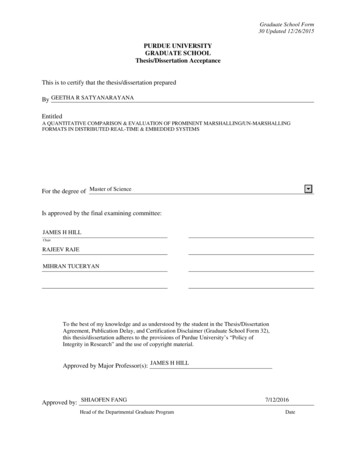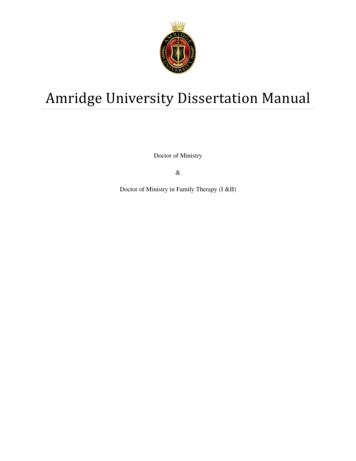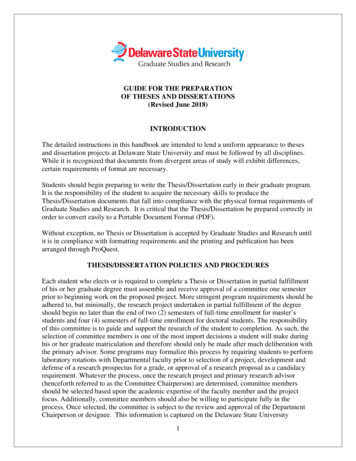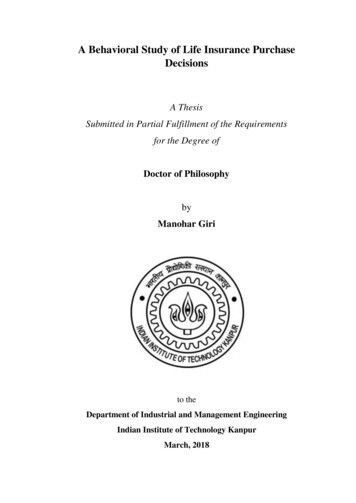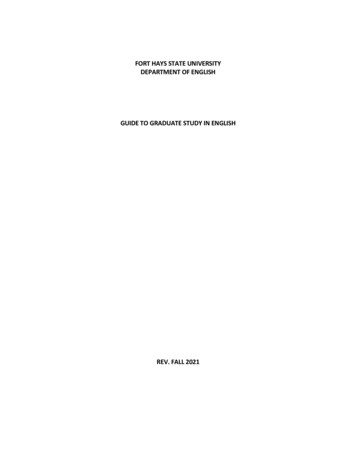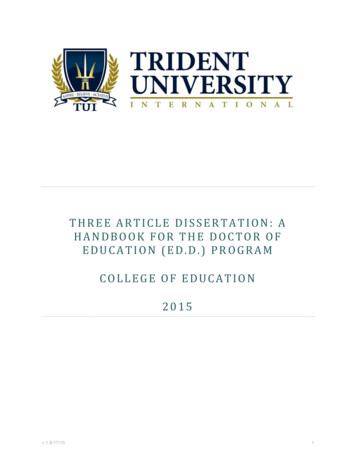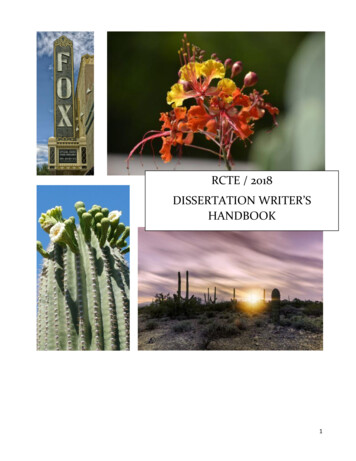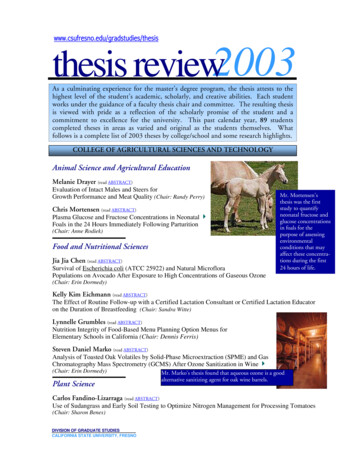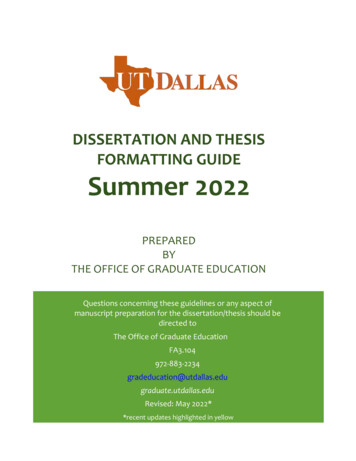
Transcription
California State UniversityNorthridgeDissertation and Thesis Format Guide:Instructions for Preparation and SubmissionCSUN Office of Graduate Studies275 Valera HallGraduate Studies Homepage(818) 677-4800
Table of ContentsINTRODUCTION . 4GENERAL REQUIREMENTS AND APPROVAL PROCEDURES . 6REGISTERING ON THE ELECTRONIC THESIS DISSERTATION SYSTEM (ETD). 6THESIS/DISSERTATION COMMITTEE SELECTION. 6PROJECT PLANNING FORM AND APPROVAL OF TOPIC. 7RESEARCH INVOLVING HUMAN/ANIMAL SUBJECTS. 8PRELIMINARY DRAFT APPROVAL . 8FINAL UPLOAD AND APPROVAL. 9FILING YOUR THESIS/DISSERTATION . 10DEADLINES . 10PUBLICATION EMBARGO . 11U.S. COPYRIGHT REGISTRATION AND PUBLICATION OF YOUR PROJECT . 11BINDING YOUR WORK. 11FINAL TRANSCRIPT AND DIPLOMA . 12PREPARING THE MANUSCRIPT . 13TYPEFACE/FONT SIZE . 13MARGINS. 13SPACING . 13HEADINGS . 14PAGINATION . 14TABLES, GRAPHS AND FIGURES . 15LANGUAGE CONSIDERATIONS . 15FORMAT OF THE THESIS/DISSERTATION . 16PRELIMINARY PAGES: OVERVIEW . 16TITLE PAGE . 16COPYRIGHT PAGE . 17SIGNATURE PAGE . 17ACKNOWLEDGMENTS AND/OR DEDICATION . 17TABLE OF CONTENTS. 17LISTS . 18ABSTRACT. 18THESIS TEXT . 18NOTES . 18BIBLIOGRAPHY . 19APPENDICES . 19THESIS CHRONOLOGY . 20COMMON ERRORS ON GRADUATE PROJECTS . 21Sample . 222
California State University, NorthridgeINSTRUCTIONS FOR THE PREPARATION ANDSUBMISSION OFTHESES AND DISSERTATIONS3
INTRODUCTIONThe Thesis or Dissertation identified on the student’s program is the culminating academicexperience leading to an advanced degree. A Master’s thesis is based on the results of originalresearch, which substantiates a specific view as expressed in a hypothesis, a concept, or a question.A Master’s thesis can consist of making a synthesis of existing data and/or the development of newdata in the laboratory or in the library. The term graduate project is used to describe a piece oforiginal, creative work which does not lend itself to a book format, e.g., paintings, films, ortheatrical productions. Even in some disciplines and departments where the end result of thecandidate’s work is a bound report, the term graduate project is appropriate, since the candidate’ssubject matter and research have an applied orientation. Examples of such graduate projects mightbe found in the area of engineering, computer design and curricula development, and in theimplementation of organizational structures in social systems.A Master’s thesis or graduate project provides a demonstration of a graduate student’sability to explore, develop, and organize materials relating to a specific problem or an appliedorientation within a field of study. The student must exhibit the ability to pursue an extendedscholarly statement in a clear, direct, and concise manner. The university retains an approvedelectronic version through Scholarworks@CSUN. This allows the work to be publicly available toother students, faculty, and outside researches. The thesis or the graduate project, therefore,becomes a visible and permanent measure of the quality of scholarship expected of a graduatestudent.A written Doctoral Dissertation is the major benchmark required in CSUN’s Doctoralprogram. All candidates complete a Dissertation based on a review of the literature and originalresearch on a problem. The primary goal of the Dissertation is to generate applied knowledge thatcontributes to the understanding and improvement of practices, policies, or reforms. TheDissertation is a contribution to the field that demonstrates the candidate’s scholarship, researchskills, and insight into a particular problem.The Doctoral Dissertation at CSUN is a significant scholarly work that uses rigorousresearch methods in the study of problems, practices and the application of problem-solvingstrategies. The Dissertation is expected to be based on one or more theoretical frameworks and toinclude a comprehensive review of relevant literature. The Dissertation typically involves collectionof empirical data, qualitative and/or quantitative analysis of these data, interpretation of thefindings, discussion of their significance and implications, and recommendations of important areas4
for action as well as further study.The Graduate Studies Committee has adopted a body of regulations and criteria thatestablishes uniformity in physical format for all theses, dissertations submitted in fulfillment ofrequirements for advanced degrees. As a graduate student, not only are you required to follow theguidelines and specifications established by your department and committee for the completion ofyour thesis or dissertation, but you must also comply with the requirements of the Graduate StudiesCommittee concerning the physical format of your manuscript as established in these instructions.Never use as a precedent dissertations or theses on file in the University Libraries or in youracademic department because the manuscript requirements have changed over the years.Before beginning work on a thesis or dissertation, you must receive approval of theproposed subject matter from the faculty committee in charge of your program. Your committeehas responsibility for both the content and written style of the manuscript. You must receiveapproval in both areas. Style, including footnote and bibliographic form, is at the discretion ofyour committee so long as consistency is maintained throughout the manuscript. For assistance inresolving questions concerning style, you and your committee may consult established manuals ofstyle (such as the Chicago Manual of Style, Elements of Style by Strunk and White, or the MLAStyle Sheet) or manuals of style specific to your area of expertise (such as the AmericanPsychological Association Manual). Using these style guides will help you, but be carefulbecause Graduate Studies regulations may differ slightly.5
GENERAL REQUIREMENTS AND APPROVAL PROCEDURESThis section outlines the responsibilities and procedures that students must follow withregard to the completion of a Master’s thesis or Doctoral dissertation. For additional questions,students should contact their department’s graduate coordinator or their committee chair. Thefollowing standards and procedures apply to all graduate programs at California State University,Northridge. The students, however, are required to check the standards and procedures required bytheir specific department or program. Graduate programs may have more stringent requirementsthan those of Graduate Studies.Note: that only fully classified students are allowed to work on their culminatingexperience. Thus, conditionally classified students are not allowed to register for the ETD system.REGISTERING ON THE ELECTRONIC THESIS DISSERTATION SYSTEM (ETD)The first time you log into ETD, (ETD Login) you will be prompted to register. Click on the“Register Here” link and complete the Student Information page. Clicking the “Register” buttonwill complete the registration page and bring you to your home page. From here, you will be able tocomplete your Planning Form. Upon successful completion of registration, deadlines for the ProjectPlanning Form, Preliminary Draft and Final submissions will appear for your expected graduationsemester. Students are responsible to adhere to these deadlines. For help with using the ETDsystem, see the online tutorial at: ETD Help DeskTHESIS/DISSERTATION COMMITTEE SELECTIONA minimum of three individuals who do not have a conflict of interest with the student, mustserve on a student’s committee. A conflict of interest is defined as a person who has an economic,sexual, and/or romantic involvement with the student or a member of the student’s immediatefamily that could reasonably be perceived as impairing objectivity. The chair of the committee mustbe a tenured or tenure-track faculty member of the department or academic degree grantingprogram. The majority of members of the committee must be active members of the department orprogram. Active members include all tenured and tenure-track faculty and lecturers affiliated withthe department or program—as defined by the graduate coordinator. Faculty participating in theFaculty Early Retirement Program are considered active faculty members and, as such, can serve aseither the chair or a committee member. Some departments or programs may have alternate policiesapproved by the Graduate Studies Committee. A minority of committee members may be drawnfrom outside the department or program, either from within or outside of the university. Like all6
committee members, such outside members must (a) have a graduate degree in a related field, or (b)have extensive experience in the topic, and (c) demonstrate professional recognition throughpublications, creative activities, reports, papers or membership in a national professionalorganization and/or working committees in their institution. Individuals from outside the universitymust submit a CV to, and be approved by, the graduate coordinator of the department or program.Once you have formed your committee, you will need to register through the Electronic Thesis andDissertation (ETD) website. A curriculum vitae of a part-time faculty member or off-campuscommittee member must be uploaded electronically on the ETD website for approval by yourcommittee chair, department graduate coordinator, and the Associate Vice President of GraduateStudies.PROJECT PLANNING FORM AND APPROVAL OF TOPICOnce you have formed your Thesis/Dissertation Committee, you will need to complete theProject Planning Form on the Electronic Thesis Dissertation (ETD) system, accessible at ETDLoginThe planning form is brief and requires basic information such as the title of your graduateproject, the names of the members of your graduate project committee, and the email addresses ofyour committee members. Please use the campus email of any on campus committee members inorder to avoid the email being sent to a spam folder. If for some reason a committee member doesnot receive an email from the ETD system, they can simply visit ETD Homepageto register and access ETD. If the wrong email is entered in the planning form, please call the ITdepartment at (818) 677-1400 for assistance. For help using the ETD system, visit the online tutorialat: ETD Help DeskNote: that the Curriculum Vitae for any off-campus member of your thesis committee mustbe uploaded on the ETD system at this stage. Before starting your project, the student must obtainthe approval of all members of his or her project committee. Similarly, and elaborated below,students who, as a part of their thesis, conduct human or animal research that requires campusapproval must apply for and receive that approval BEFORE they begin their research. Additionallevels of approval, outside of CSUN, will be required before the initiation of studies taking place inmany off-campus locals, such as in the LAUSD or in a state or federal agency. Students areresponsible for making sure their committee signs the Project Planning Form in order to move to thenext stage.7
RESEARCH INVOLVING HUMAN/ANIMAL SUBJECTSFederal law and university regulations require students who conduct research involvinghuman and/or animal subjects to obtain institutional clearance before beginning such research. Ifyou plan to test a hypothesis using humans as subjects, you must prepare a protocol indicating howyou will protect the human subjects from unacceptable risk or harm, gain their consent, and ensureconfidentiality. You must clear that protocol through a departmental review committee and thecampus Standing Advisory Committee for the Protection of Human Subjects. Protocols utilizinganimal subjects must be approved through a departmental review committee and the campusInstitutional Animal Care and Use Committee. Forms are available at: IRB HomepageFor questions, contact the Office of Research and Sponsored Projects Compliance Officer at818-677-2901.PRELIMINARY DRAFT APPROVALThe format review for your thesis/dissertation is submitted electronically at ETDLogin .Only after your planning form has been completed will you be permitted to submit yourcompleted working preliminary draft for format review. Once you submit the completed workingdraft, your Graduate Evaluator will be notified and your document will be reviewed.Preliminary draft stage requires that students have a completed working draft. Thismeans your Roman Numeral sections, references, and appendices must be completed.The Graduate Evaluator will review a complete online preliminary draft ofyour thesis/dissertation to determine whether the format complies with all Universityrequirements. If it does not, it will be rejected, and formal approval will be delayed until necessaryrevisions are made. Therefore, it is required that you resubmit a revised copy electronically ofyour thesis/dissertation for preliminary approval. Once the corrections are made to the document, itmust be re-submitted to ETD at ETD Login.8
FINAL UPLOAD AND APPROVAL1. FILE SIZE LIMITThe final upload in ETD may not exceed 4GB in size. This includes thethesis/dissertation/graduate project document as well as any supplementary materialsthe student decides to attach.2. COMMITTEE APPROVALThe document must be submitted to your Thesis/Dissertation Committee in a timelymanner for each to read and suggest revisions prior to their final approval. Should yourthesis/dissertation require approval during a Summer Session, it is imperative that youcoordinate in advance with your Committee in order to obtain their electronic approval priorto the deadline. It is best for you to check with your committee members for departmentregulations, since departments often set additional deadlines. Your committee is required tocertify the academic soundness of your work and verify that it meets the academic standardsof the degree sought. Committee members must approve through the ETD system. Pleaseuse the following link should any issues arise while attempting to submit via ETD ETDLogin.3. GRADUATE STUDIES APPROVALYour committee approved final draft must be submitted to ETD on or before thepublished deadline for the semester. The thesis/dissertation must be submitted as one PDFdocument. Once the steps above have been completed, the Office of Graduate Studies willreview your final version and academic file for completion of degree requirements.9
FILING YOUR t DeadlineAll graduate projects at CSUN must be submitted online to the ETD website. Emailattachments, electronic files, and paper copies brought into the Graduate Studies office cannot beaccepted. Dates for electronically filing your project with the Graduate Studies Office arepublished each semester on the Graduate Studies website at ETD Deadlines as well as on ETD whenyou register. It is your responsibility to know and abide by these dates. The deadline for filingwith the Graduate Studies Office is always 5pm. This deadline is strictly observed. Additionalinformation regarding the submission of graduate projects can be found below. University policyrequires that you must be an enrolled student the semester you graduate.Graduation DeadlineDeadlines for submission of your Degree Completion & Diploma application students mustapply for graduation the semester before they plan to graduate. The Application for Graduation isnow available online. To be eligible to apply graduates will need to be in classified status and havecompleted or be in progress of completing 18 units. Students should apply a year in advance of theirintended graduation date. The specific graduation deadlines for application submission appear in thelink provided:Deadlines to Apply to GraduateNote: If you need more time to complete degree requirements and has already submitted theApplication for Graduate Degree and Diploma, you must submit a “Change of Date form” alongwith an 8 processing fee. The form can be found on the CSUN Graduate Studies website under the“Forms” tab.10
PUBLICATION EMBARGOAll CSUN thesis/dissertations that are approved within the ETD system are made publicwithin ScholarWorks. If you request to delay the release of your work, prior approval from thecommittee chair must be obtained. Students who use this option are typically planning to publish allor part of the thesis/dissertation in the near future. The longest delay CSUN will currently allow is 2years.U.S. COPYRIGHT REGISTRATION AND PUBLICATION OF YOUR PROJECTUnder the Copyright Act of 1976, your thesis will automatically be copyrighted withoutnotice or registration with the U.S. Copyright Office and no one can legally copy your workwithout consent for your lifetime plus 70 years.In order to register your work with the Library of Congress, you may obtain thenecessary forms and information from http://www.copyright.gov. If you have questionsabout copyright law, please contact the U.S. Copyright Office (1-202-707-3000 orCopyright.gov Website).If your graduate work was supported by outside agencies, you may have specialobligations with respect to copyrighting your graduate project. Please consult the conditionspertaining to the award for further clarification.BINDING YOUR WORKBinding your work is optional. Printed copies of theses/dissertations are not currently beingproduced or required; therefore, you are not obligated to order bound copies. There are options forprinted copies, such as Kater Krafts who has bound theses for CSUN in the past. If you do orderprinted copies from Kater Krafts, please keep in mind that it may take a few months before theyarrive.If your advisor or department would like a printed copy, you are responsible for creating theprinted version of your graduate project. Quickcopies, on campus, for a fee, will print your graduateproject, reduce your graphs, and bind any of your extra copies in a hard or soft format for yourpersonal use. You may also opt to use another printing and binding company of your own choosing.11
FINAL TRANSCRIPT AND DIPLOMAThe official transcript with the degree posted will be available approximately 4 weeksafter the date on which your master’s degree was officially conferred. Your official transcriptwill not be generated automatically. Official transcripts can be ordered online through theMyNorthridge portal. Transcripts can also be requested, in person, or by mail, with the requestform from Admissions and Records.Approximately 4-6 weeks after your official degree conferral date, you will receive yourdiploma via USPS to the address on SOLAR. Diplomas are mailed to the address listed in SOLAR.It is your responsibility to keep that address current. Otherwise, your diploma will be mailed to thewrong address and you will have to request, and pay for, another diploma. After graduation, and foran indefinite period of time, you will have access to: SOLAR, CSUN email account, and theMyNorthridge portal.Please note that the end of the semester is not the date of degree conferral, nor iscommencement. Degrees may take several weeks following the end of the semester to be conferred.NEED HELP?The Graduate Studies Office is available Monday thru Friday from 8am to 5pm to edu). We are located in the University Hall, Room 275. You may alsovisit Graduate Studies Homepage for additional links and information.12
PREPARING THE MANUSCRIPTTYPEFACE/FONT SIZEThe type size used should be 10 or 12-point overall and should remain consistentthroughout the document. A notable exception to this rule is in tables and figures. In tables andfigures, the type may be slightly smaller.The print should be black, and the characters consistently clear and dense. Use Times NewRoman throughout the manuscript. Confirm that the typeface of your page numbers matches thetext. Do not use script or italics as the main type face; use it only as necessary for book titles, Latinnomenclature, etc.MARGINSThe margins of one-inch (1”) on the left, and one-inch (1”) on the top, right, and bottomof the page must be observed. Tables, charts, maps, illustrations as well as appendices must havethe same margins.The choice of whether or not to justify the right-hand margin is up to students and theircommittees. We suggest that you use right-justified margins only if your software program doesthis well and does not leave large gaps in the text or separate punctuation from text characters.SPACINGFor spacing, we recommend that you contact your committee chair in regards to a stylisticpreference. The following text, may be single-spaced: Captions Footnotes Long quotations (those of more than three lines) Bibliography entries of more than one line Materials in tables and appendices (text in appendices should still be double-spaced)A blank line must appear between footnotes and bibliography entries. The text must bearranged so that gaps or white spaces within major sections are minimal. The only blank spaceshould be appearing at the end of major sections when necessary to allow the first typing of the nextmajor section to begin on a new page.Avoid widows (one line of text from the end of a paragraph appearing alone at the top of asheet of paper) and orphans (one line of text from the beginning of a paragraph appearing alone atthe bottom of a sheet of paper or a heading or subheading at the bottom of a page that is not13
followed immediately by text on that page). There should be at least two lines of text at the top andbottom of each page.HEADINGSMain headings should be centered 1 inch from the top of the page. Be consistent within eachchapter/section. All main headings should either be Bold, UNBOLD AND ALL CAPS, or FirstLetter of Each Major Word is capitalized.Subheadings are a freestanding side heading; please contact your committee chair regardinga stylistic preference. Whatever the selected format, be consistent within each chapter/section.The subheading must either be Underlined, Italics, or in Bold print. Only one of these styles maybe used at a time.PAGINATIONTheses/dissertations are to be paginated as follows: Preliminary pagination: The title page is counted in the pagination but the number ISNOT printed on the page. All other preliminary pages are numbered with lower caseRoman numerals centered on the text at the bottom of the page below the margin line,starting with “ii.” If there is a copyright page, the numeral will be “ii” with the followingsignature page numbered “iii”. If there is not a copyright page then the followingsignature page will begin with the numeral “ii”. Main body: Numbered with Arabic numerals beginning with page "1" of theintroduction and continuing throughout, including text, figures, bibliography andappendices.Page numbers are centered on the text at the bottom of the page, below the margin line(or centered between the bottom margin and the bottom of the page). The numbers should appearwithout periods, parentheses, or dashes. Pages that are landscape oriented must still have aportrait style page number.14
TABLES, GRAPHS AND FIGURESFor tables, full-page diagrams, pages with figures or photographs, the same margins arerequired as for text pages. Full-page figures may have accompanying captions on a separate page;such figures and their caption pages must be counted and numbered.Landscape orientation may be used to print wide tables, figures, graphs and illustrations.All landscape pages must read from the bottom to the top of the paper. In other words, the top ofthe figure, when in landscape orientation, must be printed along the binding edge of the paper(left-side). The location of page numbers will remain the same (portrait style).It is recommended that figures and tables be placed as near as possible to the part of thetext they illustrate. This is to allow those reading your manuscript greater ease of access to theinformation contained in this illustrative material at the point that they first read about it.Figure and table numbering must be either continuous throughout the manuscript, orcontinuous within each chapter (i.e., 1.1, 1.2, 2.1, 2.2, etc.). The numbering method chosen mustbe consistent throughout the document. Two figures cannot bear the same number. The use ofcolor in figures, photographs, etc. is acceptable.LANGUAGE CONSIDERATIONSThe manuscript must be written using the English language. If you are required to use excerptsin a different language, the English translation must immediately follow.15
FORMAT OF THE THESIS/DISSERTATIONAfter your committee members have read and given preliminary approval of the manuscript,the final draft is to be prepared using the following format:PRELIMINARY PAGES: OVERVIEWPreliminary pagination: The title is counted in the pagination but the number is not printed on thetitle page. Make sure that you use the word “Thesis” on your preliminary pages. Preliminary pagesinclude (in the following order):
California State University . Northridge. Dissertation and Thesis Format Guide: Instructions for Preparation and Submission . CSUN Office of Graduate Studies 275 . Valera. Hall . Graduate Studies Homepage (818) 677-4800
